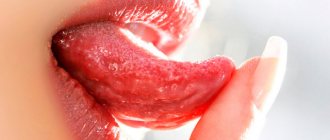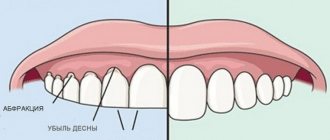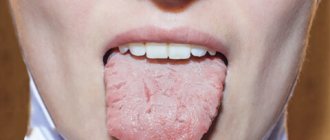Tongue abscess: Causes
Most often, the problem occurs after a small wound on the tongue becomes infected with staphylococcal and streptococcal bacteria. Damage to the surface of the tongue can be caused by constantly rubbing dentures, sharp edges of unhealthy teeth, or a prick from a fish bone. Possible cross-infection of the tongue due to purulent inflammation of the gums on the inside of the teeth. This pathology can be a complication of glossitis (mild inflammation of the tongue), ulcerative stomatitis (inflammation of the mucous tissues of the oral cavity), and sometimes acute tonsillitis (inflammation of the tonsils). The nature of inflammation and its spread are determined by the peculiar structure of the tongue. Thus, damage to one lobe of the tongue never spreads to the opposite side. The most dangerous is the location of the purulent capsule at the root of the tongue (due to the proximity of the lymph nodes).
Development of pathology
Due to the fact that the tongue does not have sebaceous glands, this organ is not capable of becoming covered with ordinary pimples. Typically, the presence of pimples under the tongue or on the surface of this area is called pustules. Lumpy formations of bright red color with a white coating appear due to damage to the damaged area of the oral cavity by bacteria of various types. Often this disease occurs after a person has bitten a place on the tongue or after eating rough food, such as candy.
Manifestations
After an injury, boils begin to form under the tongue or on its surface. This disease is called glossitis. Symptoms of the disease may be as follows:
Irritation of the damaged area that occurs after eating spicy, sour or hot food.- Further, a small tumor can be seen at this place.
- If you examine the area under the tongue or any other injured area of this organ, you may notice redness.
- Later a boil appears.
Typically, such a formation goes away on its own, without the use of medications, but if the state of immunity is weak at the moment, then there is a high probability of further spread of ulcers throughout the entire inner surface of the mouth. Therefore, it is better to start treatment immediately, at the first stage of the manifestation of unpleasant symptoms.
A consequence of glossitis can be the appearance of papillomas in damaged areas that have a rough structure.
Such complications occur only when the pathological process is advanced, when bacteria reach the deep layers of tongue tissue.
Why does it happen?
The causes of the disease are quite varied. Among the main ones are:
- tongue injuries, even microscopic;
- bad habits, such as regular drinking or smoking, are quite capable of causing pustular lesions of the mucous surface of the entire oral cavity;
- allergic reactions to any personal hygiene products, mouth rinses, toothpaste, lipstick or certain foods (rough, spicy, salty);
manifestations of thrush or tuberculosis. In this case, a person develops small ulcers on the tongue or on the side of the organ, and stay there for a long time, without growing and without causing significant discomfort;- anemia is a disease characterized by a lack of folic acid in the body, as well as vitamin B12. If a person has such a disease, then the surface of the tongue becomes smooth, and small red formations appear on the sides;
- diseases of the digestive and circulatory system. In this case, the tongue becomes covered with red spots;
- somatic illness - manifested by the appearance of a boil under the tongue. This condition indicates the development of a serious pathological process that affects the human immune system;
- stomatitis, which is more often found in children. Children often provoke this disease on their own when they constantly put dirty fingers in their mouth;
- manifestations of herpes.
Treatment for this condition depends entirely on the reasons for the abscesses. The dentist treats these formations, but often this doctor refers the patient to doctors of other specializations.
Abscess of the root of the tongue: Symptoms
The symptoms of an abscess will differ depending on the depth at which the abscess is located. There are two types of abscess:
- Superficial abscess - the epicenter of inflammation is located directly under the layer of mucous tissue. In this case, swelling and redness are clearly visualized. The swallowing process is accompanied by severe pain and body temperature rises. Spontaneous opening of the abscess is possible, after which relief occurs.
- A deep abscess is an inflammation in the thickness of the tissues of the tongue, during which the general condition can sharply worsen: a headache appears, the temperature reaches the maximum level, and fever is possible. The mental lymph nodes may also be enlarged, the tongue becomes bluish, and there is a putrid odor from the mouth.
With an abscess of the root of the tongue, severe swelling is observed, which makes it difficult not only to speak, but also to breathe.
Important! If you have any discomfort while swallowing or a feeling of tightness at the root of your tongue, you should immediately consult a doctor. Rapidly developing swelling of the tongue can lead to suffocation.
Frequently recurring abscesses in the center of the tongue may indicate a pathology of the structure of the organ (unfused blind foramen).
Reasons for the formation of pus on the tongue
Pus on and under the tongue forms for the following reasons:
- as a result of advanced glossitis;
- with mechanical damage to the epithelium of the tongue;
- when purulent pimples appear on the tongue;
- as a result of poor-quality piercing;
- with purulent sore throat.
Let's take a closer look at all these cases.
Glossitis
Inflammation of the tissues of the tongue is called glossitis (symptoms and causes of glossitis). In modern medicine, over ten different forms of this disease are distinguished. Some of them are congenital, cause no trouble to patients and do not require any treatment. However, there are also forms of glossitis that require immediate treatment and even surgical intervention. The most dangerous forms of glossitis include deep and phlegmonous glossitis. They are characterized by the formation of purulent exudate, which causes intoxication of the entire body. That is why purulent forms of glossitis require immediate treatment with antibiotics, and in more advanced and complex cases, even surgical intervention may be required.
Mechanical damage to the epithelium
If a patient's tongue is purulent, the first thing the doctor should do is examine the surface of the tongue for damage to the epithelium of the mucous membrane. The thing is that the epithelium protects the surface of the tongue from infection. If mechanical damage to the epithelium occurs, an infection may enter the wound, which causes an inflammatory process. The most dangerous consequence of mechanical trauma is an abscess; it can be both superficial and deep. The main symptoms of the disease are:
- acute pain;
- redness and swelling of the tongue;
- presence of bad breath;
- the appearance of purulent exudate;
- limited mobility of the tongue due to pain.
Purulent acne
The appearance of pimples on the tongue causes the patient a lot of trouble and discomfort. The fact is that our tongue is literally riddled with nerve endings, and the formation of even the smallest pimples is extremely painful.
Reasons for appearance:
- microtrauma;
- allergic reaction;
- stomatitis.
In case of microtrauma, spicy, salty, stingy foods should be excluded from the diet, adhering to a gentle diet. You should consume liquid pureed food that will not irritate the injured tongue. It is advisable to systematically rinse the mouth with antibacterial solutions and balms, which will prevent infection of the wound. If the wound does not get infected, it usually heals after 3-4 days from injury.
If a pimple on the tongue is caused by an allergy, you should definitely consult a doctor, determine the allergen and then try not to come into contact with it. It is advisable to take antihistamines and vitamin complexes.
If the appearance of pimples on the tongue is caused by stomatitis, you should consult a doctor and select the most effective antimicrobial drug. Children usually suffer from stomatitis, however, adults are also susceptible to this disease.
Pus after piercing
Very often, patients complain that their tongue festers after piercing. This complication usually occurs if the piercing is done incorrectly, with unsterile instruments or in inappropriate conditions. Therefore, you should only contact specialized centers where they carefully monitor the cleanliness and sterility of instruments.
If the patient’s tongue becomes suppurated after a puncture, you should immediately consult a doctor, as this is quite dangerous.
Patients often ask what to do if the tongue piercing festers. In this case, it is necessary to carefully remove the earring, carefully clean the surface of the tongue from plaque, and rinse the mouth with antibacterial solutions or decoctions of medicinal herbs. But in any case, it is necessary to consult a doctor as soon as possible, since in this case quite often it is necessary to resort to antibiotics to prevent the development of purulent complications.
If a tongue piercing is done poorly, pus usually leaks through the upper hole of the piercing. That is, it accumulates on the upper side. If the secreted exudate has a yellowish tint, it is necessary to begin drug treatment under the supervision of a doctor, since this color indicates a complication of the disease.
Purulent sore throat
If a patient is diagnosed with purulent tonsillitis, pus on the tongue may indicate a complication of the process. Typically, purulent tonsillitis is located in the tonsil area. But sometimes, especially when the condition is neglected, pus spreads to the root. In this case, there is a danger of various complications. Therefore, you should immediately consult a doctor to differentiate a sore throat from other diseases with similar symptoms, especially life-threatening diphtheria.
Tongue abscess: Diagnosis and treatment
Diagnosis includes visual examination and collection of information to determine the mechanism of injury to the surface of the tongue. To clarify the diagnosis, the following studies are prescribed:
- general blood analysis;
- culture of abscess contents;
- X-ray of the tongue to clarify the location of the abscess.
Treatment of a superficial abscess is usually conservative. Antibacterial rinses are prescribed, and sanitation of teeth damaged by caries is also recommended. Consultation with a dentist is necessary even after spontaneous opening of a superficial abscess (to prevent relapse of the disease).
Removal of a deep abscess is carried out surgically. The method of pain relief is selected individually, taking into account the general condition of the body. After the pus is discharged, breathing becomes easier and your health improves. In addition to surgery, a course of antibiotics and anti-inflammatory drugs is usually prescribed. Rinsing the mouth with antiseptic drugs continues until the painful symptoms disappear completely.
Possible complications of tongue abscess
The success of treatment and its duration largely depends on the timeliness of contacting the dentist. In mild cases, treatment takes about two weeks and the disease goes away without a trace. It is worth mentioning the danger of developing the following complications of the disease: neck phlegmon, phlegmous glossitis, mediastinitis, sepsis.
Therapeutic measures
Due to the fact that the appearance of ulcers under the tongue, on its surface and on the sides is often caused by ordinary trauma to this organ, medications are selected mainly with an antiseptic effect. Folk remedies with similar properties can also be effective.
Medication methods
Boils on the tongue are treated mainly through drug therapy; surgical methods are used only in exceptional cases. Preparations for external use:
- Iodine solution.
- Hydrogen peroxide.
- Baking soda solution.
- Propolis (tincture and spray).
- Local antibiotics (Chlorhexidine).
If treatment of a more advanced pathological process is necessary, the doctor will prescribe other medications. Therapy is selected individually for each patient.
More powerful means include:
- Flucinocide.
- Corticosteroids (Dexamethasone).
- Pain relieving ointments (Lidocaine or Benzocaine).
- Antifungal drugs (Nystatin, Levorin).
- Antiviral topical medications (Acyclovir ointment).
There are cases when ordinary stomatitis in a child or adult causes a number of severe symptoms, an increase in body temperature to high thermometer readings or swollen lymph nodes with an inflammatory process, which means the need to undergo treatment in a hospital. Often, broad-spectrum antibacterial agents (Amoxiclav, Cefixime) are added to therapy.










